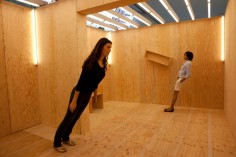Julian Hoeber
Джулиан Хобер
Demon Hill
source: highlike
Photographer: Heather Rasmussen
.
.
.
.
.
.
.
source: trendhunter
Demon Hill #2 is an art installation that plays with people’s perception of gravity. Categorized as a mystery spot or gravity hill, which are particularly popular in the United States, it is similar to the common tourist attractions that feed off of people’s cathartic feelings of being queasy, scared and disturbed.
In this case, the Demon Hill #2 is a makeshift room paneled entirely in plywood. As soon as a visitor steps into the space, gravity becomes warped and their perception of what is up or down becomes completely negligible. Barely able to squeeze into the Harris Lieberman Gallery in New York City, the Demon Hill #2 has carefully chosen features including a protruding wall, reflecting mirror and wooden chair all designed to discombobulate the participant even more.
.
.
.
.
.
.
.
source: afflante
Los Angeles-based artist Julian Hoeber created his installation (for a gallery in West Chelsea) which make visitors deliberately uncomfortable by distorting their sense of balance. Without the use of strobe lights or fake skeletons, Demon Hill 2 can make visitors queasy. A free-standing structure based on the architecture of “gravitational mystery spots” is a kind of American roadside attraction. Mystery spots usually lay claim to being sites of supernatural power or geological anomaly to explain a severe effect of disorientation and vertigo for the visitor, when in truth these effects are the result of an architectural trick. Hoeber’s version uses the same crooked structure as the roadside attraction, but reveals the device behind the hoax, while never diminishing the effect. DH#2 is a variation on Demon Hill, Hoeber’s outdoor sculpture made for the Hammer Museum in 2010.


